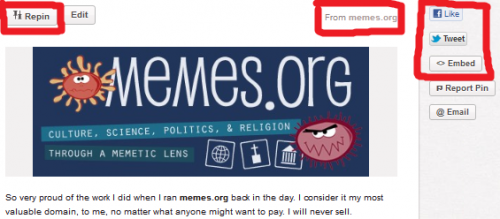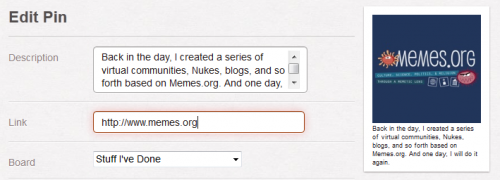If you use images or photos on any of your sites, you’re already on Pinterest, whether you’ve registered on Pinterest or not. So, what’re you going to do about it? If you’re not on Pinterest, you’re already losing control of your visual brand as we speak by virtue of not participating. Pinterest is going to push you to better brand your content and IP in such a way that people know where that content is from without imposing grotesque watermarks, oversize copyright notices, or garish splashes of brand that takes away attention from the message in the image.

So, when someone steals your image, your graphic, or your photo, will they associate it with you even if it is disassociated with your sites, blogs, or social media? I know, when you post your own pins, you can add a source link-back URL, right? I know, when people pin your content from your own blog’s “pin this” button that the link-back is attached to the image; however, most pins don’t happen in ways you even remotely control. That’s why National Geographic blocks Pinterest: losing control of IP scares the bejezus out of copyright-depended organizations like Tony Stone, National Geographic, Getty, and Corbis! The Geographic could do amazing things with Pinterest if they weren’t so threatened by it, but old media dies hard.
 But you’re not going to be lame like that, right? You’re going to share anything and everything that’ll get you and your brand noticed and pinned, right? Good. Let’s move on.
But you’re not going to be lame like that, right? You’re going to share anything and everything that’ll get you and your brand noticed and pinned, right? Good. Let’s move on.
Is there a way you can reconsider your messaging to move past logos, slogans, tag lines, copy, tweets, and posts to influential visualizations? Visualizations such as infographics, comics, cartoons, storyboards, branded screenshots as well as your products, services, management team in such a way that you don’t need to have any context or background info for these visualizations to make sense.
For those of you who don’t know about Pinterest, here’s what Pinterest says it is: “Pinterest lets you organize and share all the beautiful things you find on the web. People use pinboards to plan their weddings, decorate their homes, and organize their favorite recipes.”
I must admit that I didn’t get Pinterest at first, second, and third. But I think I get Pinterest now, and it is an essential social media branding tool whether you like it or not, whether you embrace it or not.
The most important thing that the popularity of Pinterest reminds us as marketers and social media strategists is that text can no longer stand on its own. We all know that illustrating each and every blog post with a topical and striking image can aid in curb appeal when it comes to sharing posts on Google+, Twitter, and Facebook–images add a splash of color, drawing the eye powerfully to text-only content, no matter how compelling the title.
Pinterest allows images, graphics, photos, infographics, slogans, and logos to be illustrated with text. And Pinterest holds our feet to the fire because the image leads the appeal of the content. I feel like it is safe to assume that most “repins” and shares to Twitter and Facebook are made without reading any associated textual blurbs or link-throughs.
As a communicator, I cannot assume that you have any shared experiences with me. If I want to communicate something new with you, it is essential that I don’t do it in shorthand.
In blogging and social media, this is even more essential because of sharing. Syndication and sharing chops off all context and there’s nothing beyond the share. Sorry Jacques.
My years studying postmodernism has become handy. Jacques Derrida is quoted as saying “there’s nothing beyond the text” in that “text” includes every content medium. All posts should include everything that needs to be said and cannot assume any outside knowledge. In a nutshell.
In much the same way that I have been harping on writing blog posts and online content that can be shared willy-nilly far and wide, decapitated from its home blog or home site, without losing its impact, branding, source, author, and meaning; I am now telling my clients that they need to extend their brand narrative to include visual and graphical storytelling.
Is it possible to go through your brand and commission as a series of inforgraphics? Is there a way to interpret your data, products, services, history, narrative and passion in cartoons, illustrations, charts, photographs, jokes, Internet memes, and amusing photos? Is there any way you can reenvision your brand in such a way that you can hire a professional photographer who can help turn the stuff you make and do into fetishable objets d’art–something that fiancees, interior decorators, and cooks can obsess about as they pin and repin their virtual mandala of collages and intention phrases to remind themselves of the life they want to live
If you play your cards right, you might very well become part of the vision boards people are pinning together every day in order to harness the power of intention in their lives.
Learn more about Chris Abraham at Gerris digital.



